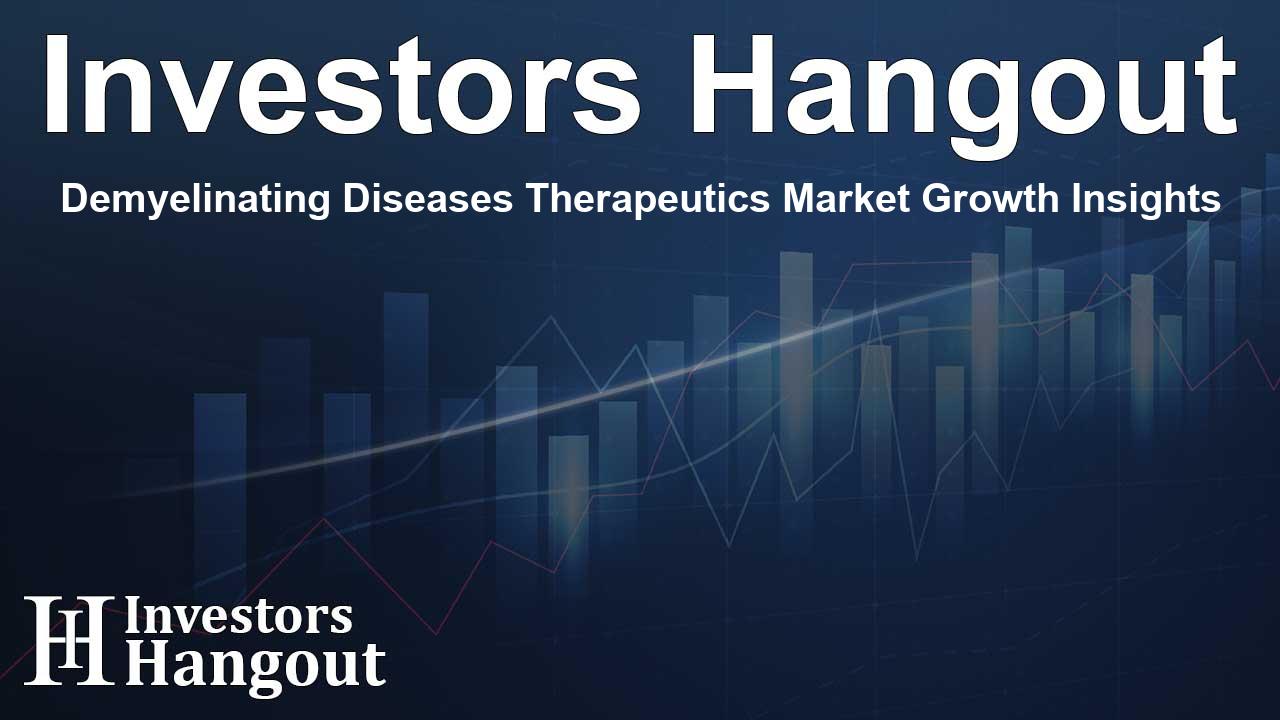Demyelinating Diseases Therapeutics Market Growth Insights

Overview of the Demyelinating Diseases Therapeutics Market
The global market for demyelinating diseases therapeutics is experiencing remarkable growth, primarily driven by the increase in neurological disorders and the development of groundbreaking treatment options. Recent projections indicate that the market, valued at around USD 25 billion in 2024, is expected to surge to an estimated USD 45 billion by 2034. This growth translates to a Compound Annual Growth Rate (CAGR) of about 6.3% between 2025 and 2034, reflecting the increasing demand for effective therapeutic solutions.
Driving Factors Behind Market Expansion
The rise in the prevalence of multiple sclerosis (MS) and other related disorders such as neuromyelitis optica (NMO) and chronic inflammatory demyelinating polyneuropathy (CIDP) is a significant catalyst for this market's expansion. The healthcare sector is witnessing a shift towards personalized medicine, biologics, and the integration of digital health, all of which redefine how therapies are developed and administered.
Market Segmentation and Product Insights
The demyelinating diseases therapeutics market can be segmented based on product type, therapeutic application, and patient demographics. Monoclonal antibodies, corticosteroids, and immunomodulators stand out in this market due to their effectiveness in managing autoimmune responses critical to these diseases.
Among the various disease segments, Multiple Sclerosis (MS) holds a commanding position due to its worldwide prevalence, affecting nearly 2.8 million individuals. Continuous research and a robust pipeline of drugs are reinforcing the focus on this segment. Conversely, conditions such as NMO and CIDP are gaining recognition, supported by advancements in diagnostic techniques and new drug approvals.
Therapeutic Applications
Disease-Modifying Therapies (DMTs) are at the forefront, helping to reduce relapse rates and slow disease progression, particularly in MS. These therapies control disease symptoms and are pivotal in enhancing patients' quality of life.
Routes of Administration and Distribution
The preferred routes for delivering these therapies include injectable, oral, and infusion methods. Injectables are particularly favored for their rapid effectiveness and widespread application in administering monoclonal antibodies. However, the popularity of oral therapies is on the rise due to their convenience, potentially leading to a shift in how treatments are delivered.
From a distribution standpoint, hospital pharmacies remain the leading channel, especially for therapies that require medical supervision. Meanwhile, online pharmacies are becoming significant players in the market, facilitated by rising internet usage and telehealth services.
Regional Insights and Global Market Landscape
North America is the foremost market, accounting for approximately 45% of global revenue in 2024. This is supported by advanced healthcare infrastructure and continuous investment in research and development. The U.S. plays a critical role, with favorable regulatory frameworks and robust pharmaceutical industries.
Europe ranks second, contributing about 30% to the total market. The burgeoning involvement of European countries in clinical research and increased public awareness have fostered growth here.
The Asia-Pacific region demonstrates the fastest growth rate, projected at a CAGR of 8% by 2034. This expansion is largely driven by economic advancements, healthcare infrastructure development, and the rising prevalence of neurological disorders.
Challenges and Strategic Opportunities
Despite its promising growth trajectory, the market faces challenges such as the high cost of therapies, particularly biologics, which may limit accessibility in lower-income regions. Moreover, lengthy regulatory approval processes and complex adherence requirements can hinder timely product launches.
Nevertheless, the adoption of digital health technologies, such as telemedicine, and the exploration of emerging markets present substantial opportunities for innovation and growth. Pharmaceutical companies are increasingly entering these developing regions to access previously underserved patient demographics.
Key Competitors in the Market
Leading companies including Biogen Inc., Novartis International AG, and Roche Holding AG are making strides in the demyelinating diseases therapeutics space. These organizations are engaged in continuous development of new therapies, posing significant competition while aiming to fulfill the rising therapeutic demands in this sector.
Recent Developments and Innovations
The market is also witnessing exciting developments. Biogen launched a new oral medication for MS, marking a significant leap in treatment options that enhance patient adherence. Other competitors such as Novartis received regulatory approval for a drug targeting neuromyelitis optica spectrum disorder, signaling an industry-wide shift towards innovative and personalized treatment options.
Additionally, Teva Pharmaceuticals is exploring AI-driven approaches for treatment optimization, showcasing the integration of advanced technologies in enhancing therapeutic outcomes.
Frequently Asked Questions
What is driving the growth of the demyelinating diseases therapeutics market?
The growth is primarily fueled by the rise in neurological conditions such as multiple sclerosis and the availability of innovative therapies.
What are the main therapeutic applications in this market?
Disease-Modifying Therapies (DMTs) and symptomatic treatments are the main applications within this market segment.
Which regions are seeing the most growth in this market?
The Asia-Pacific region is currently the fastest-growing market, driven by healthcare advancements and increasing disease prevalence.
Who are the key players in the demyelinating diseases therapeutics market?
Some key players include Biogen Inc., Novartis International AG, and Roche Holding AG, among others.
What challenges does this market face?
The high cost of therapies and lengthy regulatory processes are significant challenges impacting market accessibility and growth.
About The Author
Contact Dominic Sanders privately here. Or send an email with ATTN: Dominic Sanders as the subject to contact@investorshangout.com.
About Investors Hangout
Investors Hangout is a leading online stock forum for financial discussion and learning, offering a wide range of free tools and resources. It draws in traders of all levels, who exchange market knowledge, investigate trading tactics, and keep an eye on industry developments in real time. Featuring financial articles, stock message boards, quotes, charts, company profiles, and live news updates. Through cooperative learning and a wealth of informational resources, it helps users from novices creating their first portfolios to experts honing their techniques. Join Investors Hangout today: https://investorshangout.com/
The content of this article is based on factual, publicly available information and does not represent legal, financial, or investment advice. Investors Hangout does not offer financial advice, and the author is not a licensed financial advisor. Consult a qualified advisor before making any financial or investment decisions based on this article. This article should not be considered advice to purchase, sell, or hold any securities or other investments. If any of the material provided here is inaccurate, please contact us for corrections.
